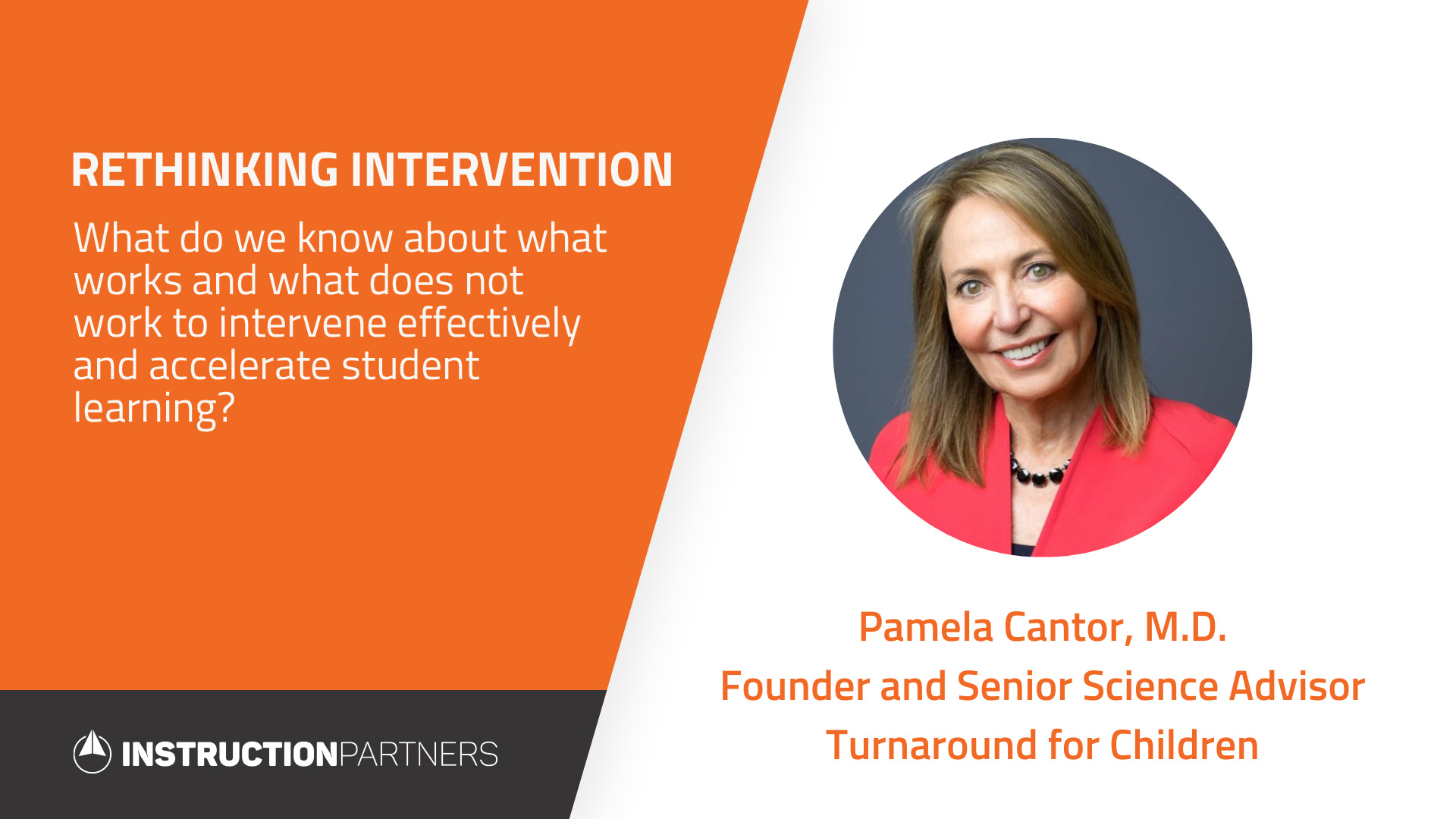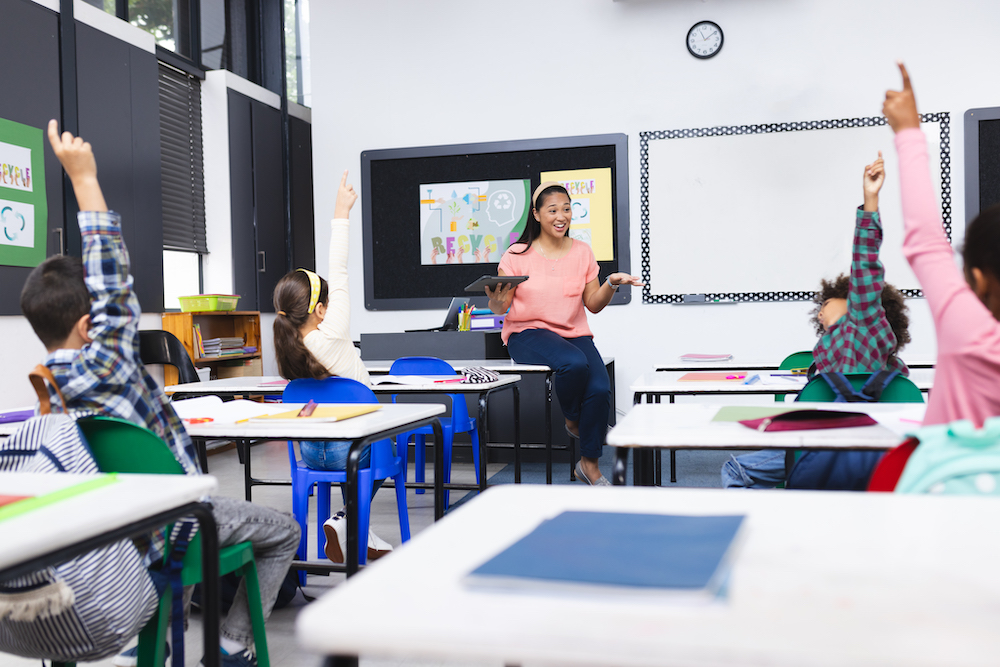
Pamela Cantor, M.D. , Turnaround for Children
Pamela Cantor, M.D., practiced child and adolescent psychiatry for nearly two decades, specializing in trauma. She founded Turnaround for Children in 2002, after co-authoring a study on the impact of the 9/11 attacks on NYC schoolchildren. Turnaround translates scientific knowledge about how children develop and learn into integrated tools, resources and services for educators, school leaders, and school systems. Turnaround’s resources to support relationships, routines, and resilience in the context of COVID-19 are available here.
Dr. Cantor spoke to Emily Freitag about the importance of creating learning environments that protect children from the damaging effects of stress when students reenter school this fall.
Watch the full conversation or read the abridged Q&A below.
Content warning: The first five minutes of this conversation includes a brief description of sexual assault.

EF: I would love to hear your own learning story.
PC: Emily, there are a lot of reasons why a person would want to go to medical school and become a doctor and mine were really clear. I went to medical school to learn about trauma, about how it affects the body and the mind. Because one day I was going to be a doctor and I would know how to heal children and help them recover from trauma. And this was because I had known trauma as a child. I grew up in a neighborhood with many cousins living nearby and there were always sleepovers. And when I was six years old, my uncle visited the room where I was sleeping and sexually abused me. He let me know that this had to be our special secret. I still don’t remember how many times it happened. But I do remember one thing, and that is that I was very afraid to tell my parents. One night, I had this dream in which I saw myself dying, and I knew it had to do with not having told my parents. And then I just had to have the courage to tell them. And my parents told me that I could never speak a word about this to anybody, or the family would be hurt. And I remember even as a six-year-old, not understanding why they seemed mad at me and not him. After that, there was no protection for years. And my mother was so ashamed that she couldn’t really care for me. And my father seemed angry all the time. So they carried this through every single aspect of my childhood until literally the day they died. And on that final day, even though their deaths were separated by 10 years, their last words to me were the same. They both said, “I’m sorry.”
I did eventually get help when I was 15 years old from this amazing psychiatrist, who was a big man, a very big storyteller with a booming voice. And he told me that I was a pearl in an oyster, not this ugly, dirty thing that I thought I was. Basically, it all boiled down to one thing—that I was good. Up until that point, I thought I was bad. So the day I came into his office, and I said to him, “I’m going to be a doctor,” and he looked at me with this big smile. And he said, “Of course you are.” I thought to myself, did he not know that up until that point, I hadn’t taken a single math or science course? I was an art major. But he had these magical powers. And I figured he got them in med school, so I had to go to med school and get them too. He was the reason I wanted to go. And he was the person who made me believe I could do it.
EF: Thank you so much for sharing your story. From your own experience and from the research you’ve seen, what do you know to be true about supporting student learning?
PC: Before we get to learning, I think we want to talk for a minute or two about what we know about the science of learning and development. I just told you a story from my life that included a very painful trauma, and it absolutely disrupted my development. But the other thing that I hope you heard and that others will hear in my story is that it wasn’t permanent. And that the trauma became the inspiration for the purpose that my life has been dedicated to since then.
If this were before COVID and the events of the past few weeks, and I had an opportunity to talk to you about the development of the brain and learning science, I would have begun with this. Each of us has 20,000 genes in our genome. That’s what each of us gets. Yet in our lifetime, fewer than 10 percent of these genes are going to be expressed. So what do you think determines what’s in that 10 percent? It’s actually context—the environments, experiences, and relationships of our lives. The context we’re exposed to is the primary driver of who we become, including the expression of our genes. The risks and opportunities in development, and evolution itself, sit inside this one profoundly important point, that there is no separation between nature and nurture, biology and environment, brain and behavior—only a collaboration between them. This means that our lives are not pre-determined by a genetic program, that in fact, genes are chemical followers. They’re little packages of protein covered with receptors that are triggered into expression by the environments, experiences, and relationships in our lives. So if nurture drives nature, this is both good and bad news. But it means that the brain is a living structure made up of tissue that is the most susceptible to change from experience of any tissue in the human body. The reason we can say that there are opportunities for growth in a time of crisis is because of our malleability as human beings.
Today, there is a pandemic inside the pandemic, where the combined effects of COVID, economic hardship, and racial injustice have dramatically escalated the inequities and magnified the uncertainties about what is ahead. That you have 1 in 3 parents of infants and toddlers skipping or reducing meals, that you have 9 million students that don’t have access to broadband, and all of this is concentrated in low-income communities— those are powerful indicators of the injustices of today, and the risks to health and academic growth that they carry.
The science of stress tells us that stress can get under the skin and into the brain and body. Adversity doesn’t just happen to children—it happens inside their brains and bodies through the biologic mechanism of stress. The experience of stress is really the interplay between two biologic systems and hormones that are chemical messengers that carry messages to the brain to the very same structure, the limbic system. And what is that? That is the learning and emotion center of our brains. One system is mediated by cortisol, which produces that fight, flight, or freeze response. The other is mediated by oxytocin, which is the hormone that produces love, attachment, trust, and safety. This hormone not only helps us manage stress, it protects us from the damaging effects of stress, and it also produces resilience to future stress. So this hormone is the most powerful hormone and the human relationship is the most powerful example of context that can protect children from the damaging effects of stress. But we have a paradox now in COVID because we’re told that to be physically safe, we have to be physically distant from one another. There’s been a huge disruption in the social connectedness of kids’ lives, of which school is such an important part. Of course, we have to maintain that connectedness by other means. And we are all trying to do that. The best will always be when we’re face-to-face, but staying connected even virtually in a time of crisis will provide the emotional fuel we need to cope and surmount this.
The burden of stress to the body and the mind is something called “allostatic load.” Although this burden can be biologically embedded it’s preventable, which is incredible, and it’s reversible, which is even more incredible. The research of people like Bruce McEwen and many others speak to the importance of activities that actually are under our control. There are activities that can help us harness the capacity of the brain to adapt, to demonstrate its plasticity, and to recover from the effects of stress. The balance between risk and protective factors in the environments that our young people and families are in can tip the balance between emotional vulnerability and mental health issues on the one side, and physical wellness and resilience on the other. This is the opportunity that we have today, both in policy and in practice, to use what we know to design environments that promote relationships, routines, and resilience. This is what Turnaround calls the “new three R’s” that actually trigger something called the upward spiral. The upward spiral is a cascade of hormones and neurotransmitters that can be recruited to combat stress and promote resilience in environments that are designed to do just that.
That is a big primer on science, but you now have the foundation and reason why I am hopeful during this time.
EF: There’s so much I’m learning in this conversation. I want to make sure I’m understanding, it’s the same things that we would do to prevent risk and to recover. Is that right?
PC: Exactly. The focus is on relationships. There is nothing more important that schools can focus on this fall than deeply knowing their kids, what their kids have experienced, what their kids have learned during this time. There are kids who are taking care of their whole families. That’s a trauma, but what does that teach a child about what they’re capable of? It would be horrible if we frame the return to school in terms of losses. Think about every book you have ever read of a young person who has faced adversity and goes on to do incredible things. What is the one thing that is true in every story? There’s a person who never gave up on them, a person who had their back, a person who knew they could do it.
EF: It’s like the hero’s journey, right? The mentor figure. Can you take us deeper into relationships?
PC: There has been a false choice in education between the things we need to do on social, emotional and cognitive development, physical and mental health, and the pursuit of academic excellence. Today we know there’s a giant body of science that tells us that a healthy context for learning requires that we pay attention to young people’s safety, social and emotional and cognitive health, cognitive development, identity, agency, and their academic skill development. Not one of these things, or two of these things, but all of these things.
EF: That has been a complete theme across all of these conversations. To the extent that we can shatter the camps that we have known, that there is abundant evidence that it is all interrelated.
PC: Emily, all I can tell you is the importance of the sentences you just said. If we build learning settings based on a set of whole-child design principles, what we are going to see is that those environments can handle kids coming into school with different developmental needs and different developmental starting points. Variation is the core of the human condition, but it is not the way our education system was designed.
So to that extent, I want to package one set of ideas. I learned about stress and the brain and learning science in the early 1980s in medical school. Think about that, the early 1980s. And it’s now 2020. I have dedicated the better part of the last 10 years to bringing this knowledge to the education community. Now there are many ambassadors. But back in the post-9/11 era, when Turnaround was founded, no one was talking about stress and the brain, and no one was looking at children’s underperformance in high-poverty settings as in any way a consequence of what adversity does to the learning systems of the brain. So I wondered if this knowledge has existed for so long, why wasn’t it already known? Why wasn’t it already embedded?
I’ve looked into the reason as a set of structural fallacies. I’m just going to tell you five, but I have plenty more. The first is that in the early part of the 20th century, we believed that genes were the drivers of who we become, including our intelligence. Today, we know that intelligence is malleable and that our environments and experiences are the determinants of who we become.
We believed that talent was scarce, that it was distributed as a bell curve, with most people falling into the middle, with a few talented people in the tails that we have to go and find. And once we go and find them, we can put them on a pathway so that they get to go to the good colleges and get the good jobs. Talent is not scarce. Talent is actually plentiful. It’s not standardized, and it doesn’t exist in society as a bell curve.
We believed that an average score, average height, average speed, stood for an individual score. Now we know that an average rarely represents the individuals that are averaged in that score. Todd Rose’s book The End of Average is an extraordinary explanation of this point.
We believed that a factory model dependent on a lot of memorization was a good and efficient way of educating children. But today, we know that engagement and agency matter far more to skill-building, mastery-level competencies, and higher-order skills.
And finally, we believed that the potential of a child was knowable in advance. Today we know that you can’t see the potential of a child unless you put that child in a context that was designed to reveal who they are. One of the things I often say in my speeches is that if a Malala, a Martin Luther King, or a Mozart were in many of our classrooms, the way our classrooms are designed today, it’s possible we wouldn’t know they were there because the classrooms are not designed to reveal them.
These are just five of the underpinnings of 20th-century design. This helps us see a roadmap for where we need to go in 21st-century design, which assumes talent is plentiful, lots of kids have it, kids don’t learn the same way, all learning is variable. How we design learning settings is actually going to determine that many, many more kids will thrive.
EF: It’s so interesting. I have thought that this pandemic is cracking schools open in ways that actually could allow for some fundamental redesign. Before this conversation, I haven’t thought of how the pandemic is creating a context that actually allows students to reveal their potential in new ways. I’m finding that very powerful.
PC: I am glad you’re seeing that because that’s what I see as well.
EF: At the same time, I want to be careful not to glorify hardship.
PC: Let me tell you another story that is really interesting. There was this famous marshmallow test in the 70s. These kids in the nursery school were put in a room with a marshmallow and they were told if they could delay eating that marshmallow for 15 minutes, they would get a second marshmallow. Walter Mischel took the data from that study and he drew these correlations between the kids who had that self -control and everything from higher SAT scores, high school graduation rates, college acceptance, and even later life success.
Then along came this researcher whose name is Dr. Celeste Kidd. She worked in a homeless shelter, and she said to herself, “Would any of my kids have ever waited to get that second marshmallow?” So she decided to repeat the test under a different set of conditions. She brought the kids into a room with a bunch of broken crayons on the table. And she said, “I’m going to come back and give you a brand new set of crayons.” And with half the kids, that’s what she did. With the other half, she came back and she said, “Sorry, I couldn’t get the new crayons after all.” Then, she repeated the marshmallow test. And what do you think happened? Well, the kids where the promise was kept had no problem with waiting to get that second marshmallow. The kids where the promise was broken gobbled up that first marshmallow right away. It turns out that the kids had the capacity for self-control and the capacity for self-management in the environment designed to reveal it. Meaning, the presence of a person they trusted. So, think about what this means for the environments that we could design to reveal the skills that kids actually have. Or think about the environments where we don’t see and can’t see the skills and talents of our kids because the environments aren’t designed to reveal them. For kids from vulnerable communities, kids who are marginalized, kids who are oppressed, they are often the kids that experience themselves as invisible in the systems that we have.
EF: That’s very powerful. I’m wondering if you could paint a picture of your worst fear about September and your biggest hope.
PC: I’ll put it into some context. One of the things we’ve established is that the brain is malleable. Everything I tell you about my best hope derives from that point. There is nothing inherently in a child that can’t be grown with the right relationships, the right experiences, and in the right environments. But, a brain under stress is shut down. It struggles to focus and concentrate, doesn’t have a lot of working memory, and is easily triggered by emotions. Many kids that we see in September are going to be just like that. The way our brains are wired, it is our emotions that drive our cognitive and learning skills. It is our emotions that engage us or shut us down.
Today in the time of COVID, and violence and racism, and inequity, we have no choice about what to prioritize. The path to a calm classroom is a calm brain. The path to learning is a calm brain. And the path to both of these is to prioritize activities that build relationships, build consistent routines, and build resilience. Relationships are the active ingredient in any learning environment because they are the way trust is built. And they are literally the fuel for the connections between brain structures that have to happen to build a complex skill. Reading alone requires at least five different structures in the brain becoming wired together, and the energy that moves those neurons is coming from relationships. It’s coming from emotions engaging us. This is what Mary Helen Immordino-Yang’s work is all about.
The brain also is a prediction machine. The brain loves to always know what’s coming next. It’s very orderly, and it gets agitated when things are unpredictable. We need classrooms that have routines that kids can count on, where kids can establish norms with their teachers, where there are prompts all over the room that give kids many different cues about what is expected of them, what they can do, where there are routine planners both for the day, but also for kids themselves, that they always know what’s coming next. All of that will be very helpful to them.
Resilience is such an interesting thing. If you talk to a person of color and they say, “Well, you don’t think I have resilience? What do you think it means for me to live in my community? I’ve got plenty of resilience.” True. But resilience can be adaptive or maladaptive. We only want to build adaptive resilience. A young person can be a leader by having a very powerful personality that disrupts an entire class. If you work with that same child to build their regulatory skills, so they know how to use that leadership for a good purpose, what you’re going to see is not just better learning and not just better behavior in class, but more adaptive resilience-building skills. So Turnaround crystallized a giant amount of science into those three words. And our website is loaded with resources for very specific practices and tools, all of which are open-source to support teachers in applying those practices in their classrooms in September.
EF: Who else should we be learning from?
PC: Our 180 podcast is in many ways a journey through everything we’re talking about now to reimagine what our education systems could be. For understanding racial identity and the consequence of this trifecta of challenges, I would say anything that Margaret Beale Spencer is writing about that relates to contexts, including the context of the police. Her work is extraordinary. She’s at the University of Chicago. Na’ilah Suad Nasir is the head of the Spencer Foundation, and her work on African American identity is hugely important. Another person that you may want to check out is Phil Fisher at the Center for Translational Education in Oregon. Phil created this amazing survey where basically he is getting a snapshot about how kids and families are doing in real-time across the country.
So, the last thing is what am I worried about? My biggest worry is that there has been so much strain on families and our system that it could take the easy way out and snap back. My gut tells me that we have a better shot than ever before of making transformational change. But, I am very worried about something I saw happen after 9/11. After 9/11, we knew that we had nowhere near the mental health capacity to serve the kids who needed mental health services in New York. We were sure that with all the philanthropic money that we had gotten, that we were going to change the mental health system forever. We didn’t. If anything, it’s worse now than it was then. A crisis can lull you into some belief that you will finally make the changes that you’ve known had to be made for a long time. That, of course, is my hope. The other possibility is that when the heat’s off, the system snaps back to its more comfortable place. I’m certainly going to be one of many people fighting to keep that from happening, and hopefully, you are too.


